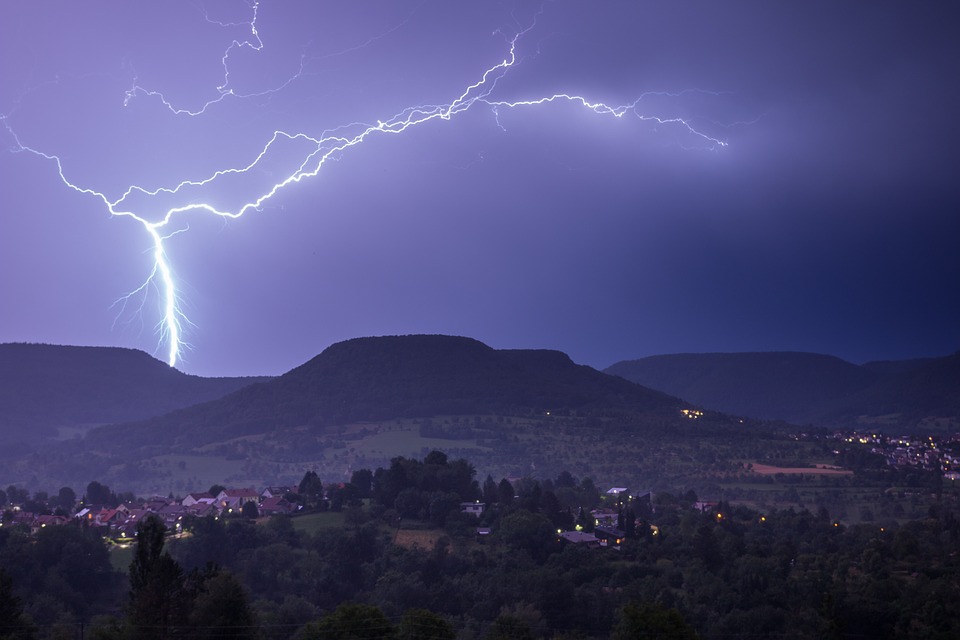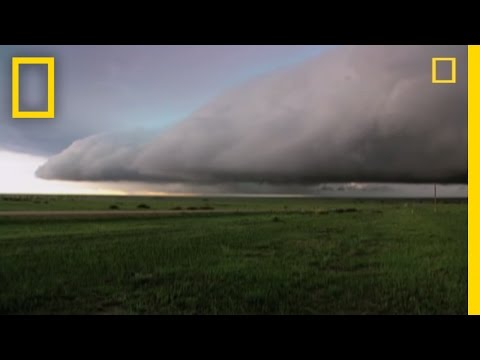11.5: Thunderstorms
- Page ID
- 12863
 Weather happens every day, but only some days have storms. Storms vary immensely depending on whether they’re warm or cold, coming off the ocean or off a continent, occurring in summer or winter, and many other factors. The effects of storms also vary depending on whether they strike a populated area or a natural landscape. Hurricane Katrina is a good example, since the flooding after the storm severely damaged New Orleans, while a similar storm in an unpopulated area would have done little damage.
Weather happens every day, but only some days have storms. Storms vary immensely depending on whether they’re warm or cold, coming off the ocean or off a continent, occurring in summer or winter, and many other factors. The effects of storms also vary depending on whether they strike a populated area or a natural landscape. Hurricane Katrina is a good example, since the flooding after the storm severely damaged New Orleans, while a similar storm in an unpopulated area would have done little damage.
Thunderstorms are extremely common: Worldwide there are 14 million per year; that’s 40,000 per day! Most drop a lot of rain on a small area quickly, but some are severe and highly damaging. They form when ground temperatures are high, ordinarily in the late afternoon or early evening in spring and summer. The two figures below show two stages of thunderstorm buildup.
Thunderstorm Genesis
All thunderstorms go through a three-stage life cycle. The first stage is called the cumulus stage, where an air parcel is forced to rise, cool, and condense, called the lower condensation level, to develop into a cumulus cloud. The process of water vapor condensing into liquid water releases large quantities of latent heat, which makes the air within the cloud warmer, and unstable causing the cloud continues to grow upward like a hot air balloon. These rising air parcels, called updrafts, prevent precipitation from falling from the cloud. But once the precipitation becomes too heavy for the updrafts to hold up, the moisture begins to fall creating downdrafts within the cloud. The downdrafts also begin to pull cold, dry air from outside the cloud toward the ground in a process called entrainment.
Once the precipitation begins to fall from the cloud, the storm has reached the mature stage. During this stage, updrafts and downdrafts exist side-by-side and the cumulonimbus is called a cell. If the updrafts reach the top of the troposphere, the cumulus cloud will begin to spread outward creating a defined anvil. At the same time, the downdrafts spread within the cloud and at first make the cloud become wider, but eventually overtaking the updrafts. Cool downdrafts form when precipitation and the cool air from entrainment are dragged down to the lower regions of a thunderstorm. It is also during the mature stage when the storm is most intense producing strong, gusting winds, heavy precipitation, lightning, and possibly small hail.
Once the downdrafts overtake the updrafts, which also prevents the release of latent heat energy, the thunderstorm will begin to weaken into the third and final stage, called the dissipating stage. During this stage, light precipitation and downdrafts become the dominate feature within the cloud as it weakens. In all, only twenty percent of the moisture within the cloud fell as precipitation whereas the other eighty percent evaporates back into the atmosphere.

With severe thunderstorms, the downdrafts are so intense that when they hit the ground it sends warm air from the ground upward into the storm. The warm air gives the convection cells more energy. Rain and hail grow huge before gravity pulls them to Earth. Severe thunderstorms can last for hours and can cause a lot of damage because of high winds, flooding, intense hail, and tornadoes.Thunderstorms can form individually or in squall lines along a cold front. In the United States, squall lines form in spring and early summer in the Midwest where the maritime tropical (mT) air mass from the Gulf of Mexico meets the continental polar (cP) air mass from Canada.
So much energy collects in cumulonimbus clouds that a huge release of electricity, called lightning, may result. The electrical discharge may be between one part of the cloud and another, two clouds, or a cloud and the ground.
Lightning heats the air so that it expands explosively. The loud clap is thunder. Light waves travel so rapidly that lightning is seen instantly. Sound waves travel much more slowly, so a thunderclap may come many seconds after the lightning is spotted.Thunderstorms kill approximately 200 people in the United States and injure about 550 Americans per year, mostly from lightning strikes. Have you heard the common misconception that lightning doesn’t strike the same place twice? In fact, lightning strikes the New York City’s Empire State Building about 100 times per year.
- Dynamic Earth: Introduction to Physical Geography. Authored by: R. Adam Dastrup. Located at: http://www.opengeography.org/physical-geography.html. Project: Open Geography Education. License: CC BY-SA: Attribution-ShareAlike
- Storm Flash. Provided by: Max Pexel. Located at: http://maxpixel.freegreatpicture.com/Storm-Flash-Thunderstorm-Flash-Of-Lightning-862620. License: CC0: No Rights Reserved
- Rolling thunder cloud. Authored by: John Kerstholt. Located at: https://en.Wikipedia.org/wiki/File:Rolling-thunder-cloud.jpg. License: CC BY-SA: Attribution-ShareAlike
- Lightning Strikes. Authored by: National Geographic. Located at: https://youtu.be/H_MG__53wsM. License: All Rights Reserved. License Terms: Standard YouTube License
- Thunderstorm formation. Provided by: NOAA. Located at: https://en.Wikipedia.org/wiki/File:Thunderstorm_formation.jpg. License: Public Domain: No Known Copyright



